How Did People Communicate at the First Thanksgiving?
This time of year, American newspapers are awash with editorials on how to talk about touchy topics with family members at Thanksgiving. The day, which commemorates the first English settlers coming together with Native Americans to celebrate their good fortune in the New World, feels to many people more like the high holiday of unwelcome conversations with relatives. Family drama is an inexhaustible font of controversy, and this year is always the most important year in political history, so engaging with loved ones in a healthy manner is vital but challenging affair.
I have written elsewhere about how to approach difficult debates, but this year, I would like to shine a light on people whose problems (communication and otherwise) make all of ours pale in comparison: the men and women, of vastly different cultural and linguistic backgrounds, who invented this holiday 402 years ago.
If you are anything like me, the first thing you wonder when you hear about Pilgrims and Indians celebrating the first Thanksgiving is how on earth they managed to communicate with one another. The inhabitants of Plymouth were religious refugees from England who had had the ill fortune to land in New England with little food shortly before the onset of winter in 1620. The fact that they were still alive to celebrate the next November is largely thanks to two men who rank among the most important linguists in human history.
Samoset was a chief of the Abenaki people in what is now coastal Maine, who learned some English from merchants who bought fish from his tribe. He was on a diplomatic mission in the winter of 1621, when he heard some strange foreigners had arrived nearby. On March 16, he sauntered into the middle of the English camp, and asked for a beer.
He ended up spending the night with the English, and enjoyed himself so much that he came back a few days later with five of his friends. Among these was a man named Squanto. Squanto was a Patuxet from near Cape Cod, who had been taken captive by an English pirate and brought back to Europe. He ended up in London, where he lived for several years, apparently as some kind of live-in management consultant to a wealthy merchant conducting trade in the New World. When he finally came home, he discovered that his relatives had disappeared (probably from disease), and he joined up with the related Wampanoag tribe Samoset was visiting. His fluency in some mysterious tongue probably seemed like a pointless party trick to his new friends, but then the entire world changed.
Samoset, Squanto, and the Wampanoags all spoke related Algonquin languages. Of course, they had absolutely zero relation to English, which made things pretty difficult for the new neighbours. Miscommunications, especially over starving Englishmen taking buried food stores they thought were abandoned, nearly started wars several times in the first months of contact. It was thanks almost entirely to Squanto that they learned to farm maize, and established peaceable relations with the Wampanoags.
Still, relatively few people on either side bothered to learn the other’s language. Samoset, Squanto, and an Englishman named John Eliot, who translated the Bible into the Algonquin Natick dialect, were the exceptions. Roger Williams, the dissident founder of Rhode Island, did try to make his fellow settlers learn native languages, to little avail.
So, at the iconic feast in 1621, members of the two communities must have communicated as people normally do in such situations: in an awkward mishsmash of words from different languages that linguists refer to as a pidgin. In the process, nascent American English absorbed some of the Indians’ vocabulary, and even their cultural prejudices: “eskimo” is an Algonquin slur implying that their northern neighbours ate raw meat (the word “cannibal” has an analogous history in the Caribbean).
Eventually, English won out. By the 19th Century, those Native Americans left in New England had stopped bothering to pass down their ancestral tongues. While a few people still speak native languages elsewhere in North America, they are probably on their way out. But this raises a second Thanksgiving question, with more lasting importance than the first: what sort of English did the Pilgrims speak?
You can get a good idea of it from the most famous text in the English language. The King James Bible was published in 1611, just nine years before the Mayflower set sail. Its language is relatively formal, but it was meant to be comprehensible to any peasant or schoolboy in England.
At the time, the language was undergoing some important shifts. The Great Vowel Shift, before which all English speakers sounded something like modern Scots, was solidifying. Of greater social importance was the gradual obsolescence of the informal pronouns “thou” and “thee,” in favour of the formal “you.” After centuries of lexical chaos, standard spelling was beginning to take root, thanks in large part to the one standard text everybody read each Sunday.
What may be more surprising to modern readers is the fact that Englishmen of 1621 sounded more like today’s Americans than Britons. What we think of today as the standard British accent first developed in London in the early 19th Century. Before that time, people on both sides of the Pond pronounced their vowels and their R’s the way Americans do today.
So, if a modern American were able to attend this legendary dinner party four centuries ago, a lot of the conversation would probably would not sound that unfamiliar. As ever, chatting about the increasingly chilly weather and recent family drama would probably be dominant themes. Of course, it would be a lot more challenging to hack together a conversation with the new neighbours we invited over in an effort to get along. America’s forefathers overcame a lot of challenges, linguistic and otherwise, to enjoy this holiday. Hopefully people today can as well.
